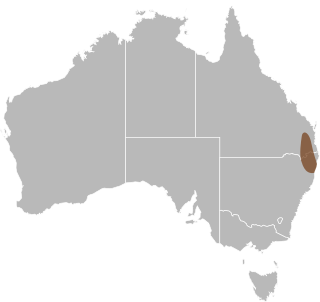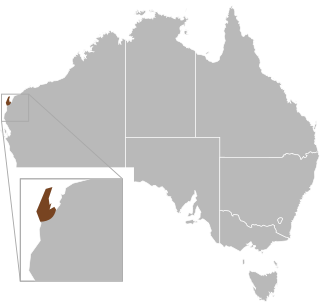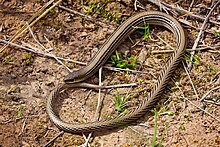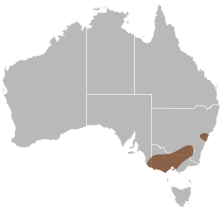
Delma is a genus of lizards in the family Pygopodidae. The genus Delma contains 22 valid described species, all of which are endemic to Australia.

Threatened fauna of Australia are those species and subspecies of birds, fish, frogs, insects, mammals, molluscs, crustaceans and reptiles to be found in Australia that are in danger of becoming extinct. This list is the list proclaimed under the Australian federal Environment Protection and Biodiversity Conservation Act 1999. The classifications are based on those used by the World Conservation Union (IUCN), however IUCN and Australian rankings do differ. Each state and territory has its own legislation relating to environmental protection.

The common death adder is a species of death adder native to Australia. It is one of the most venomous land snakes in Australia and globally. While it remains widespread, it is facing increased threat from the ongoing Australian cane toad invasion.

The collared delma or adorned delma is the smallest species of lizard in the Pygopodidae family endemic to Australia. Pygopopdids are legless lizards, so are commonly mistaken for snakes. They are distributed mainly across south-east Queensland and northern New South Wales, in both forests and some suburban areas. They are active during the day, seen foraging and hunting for small insects.
Scottsdale Reserve is a 1,328-hectare (3,280-acre) nature reserve on the Murrumbidgee River in south-central New South Wales, Australia. It is 79 kilometres (49 mi) south of Canberra, and 4 kilometres (2.5 mi) north of Bredbo. It is owned and managed by Bush Heritage Australia (BHA), which purchased it in 2006. The purchase was supportive of projects aiming to connect existing fragmented remnant habitat such as K2C. Since the 1870s up until 2006, the land was used for agriculture – primarily sheep grazing with some minor cropping. A significant component of the Reserve has been cleared of native vegetation.

Burton's legless lizard is a species of lizard in the family Pygopodidae. The species lacks forelegs and has only rudimentary hind legs. Pygopodid lizards are also referred to as "legless lizards", "flap-footed lizards" and "snake-lizards". This species is native to Australia and Papua New Guinea.

Cryptoblepharus virgatus, also commonly known as striped snake-eyed skink, cream-striped shinning-skink, wall skink, fence skink or snake-eyed skink is a skink commonly found in southern and eastern Australia. It is an active little lizard, and if threatened will often play dead to confuse the attacker.

Delma molleri is a small [the snout-vent length of the largest specimen measured 111 mm (4.4 in)], limbless lizard found in southern South Australia around the Adelaide Hills, and pretty common in Adelaide suburbs. Delma molleri has been recorded from a variety of habitats ranging from grassland to woodland beneath rocks, timber, and rubbish. The species is oviparous.

A spur is an outgrowth of bone covered in a sheath of horn found in various anatomical locations in some animals. Unlike claws or nails, which grow from the tip of the toes, spurs form from other parts of the foot, usually in connection with joints where the toes meet the foot or the foot meets the long bones. Spurs are most commonly found on the hindfeet, though some birds possess spurs at the leading edge of the wings.

The pink-tailed worm-lizard or granite worm-lizard is a rare legless lizard found in Australia. The animal looks like a combination of small snake and worm. Its total length is up to 14 cm. It has a pink tail and is white underneath. The head and neck are brown, and the rest of the top of the body is pale grey. Scales on the back each have a dark bar, giving the appearance of dots down the back. It is found on two hills near Tarcutta, Bathurst, New South Wales, Bendigo in Victoria, and along the sides of the Molonglo River and Murrumbidgee River and on Mount Taylor in the Australian Capital Territory. The lizards eat invertebrates that live under rocks. They can be found under rocks sized from 0.15 to 0.6 m. Their main diet is ant eggs, particularly from Iridomyrmex species and Rhytidoponera metallica.

Anniella stebbinsi, the Southern California legless lizard, is a small, slender lizard, and, as the name suggests, is legless. Not much is known about the Southern California legless lizard as a separate species, with most observations conducted while it was not recognised as separate from Anniella pulchra.
The eastern hooded scaly-foot or eastern scaly-foot is a species of flap-footed lizard found in the complex heaths of the lower west coast and the spinifex grasslands of mainland Australia. They are popular pets and are often mistaken for snakes due to their limbless appearance

The Delma australis is often known as the southern legless lizard, or the marble-faced delma. This terrestrial lizard falls into the category of slender Pygopodidae, a legless lizard. There are 21 known species in the Pygopdidae family in Australia. Marble-faced delmas are endemic to Australia. Delma australis was first described by Kluge in 1974.

Delma butleri, also known commonly as Butler's legless lizard, Butler's scalyfoot, the spinifex snake-lizard, and the unbanded delma, is a species of lizard in the family Pygopodidae. The species is endemic to Australia.

The North West Cape delma, also known commonly as Teale's delma, is a species of lizard in the family Pygopodidae. The species is endemic to Western Australia.

The excitable delma is a species of lizard in the Pygopodidae family endemic to Australia. The lizard gets its name from its active and jumpy defense mechanism. It will erratically jump multiple times in succession, each jump pivoting its body in a different direction. D. tincta is a slender, long legless lizard that through evolution lost its limbs. It is found throughout Australia in a variety of habitats, and spends most of its time hiding. Due to its nocturnal nature, it is rare to spot in the wild. This legless lizard is small to moderate in size, with a tail that is three to four times its body length. The typical size of the excitable delma is 250 – 300 mm. This lizard is an insectivore and feeds on insects it finds when travelling through grass, logs, surface soil, and loose rocks. Like all pygopodids, the excitable delma is oviparous and only lays two eggs per clutch.

The Patternless Delma is a small species of legless lizard from the Pygopodidae family, endemic to Australia. This species is commonly found throughout New South Wales (NSW), southeastern South Australia (SA) and southeastern Queensland, inhabiting areas including dry to temperate southern grasslands and grassy woodlands.

















